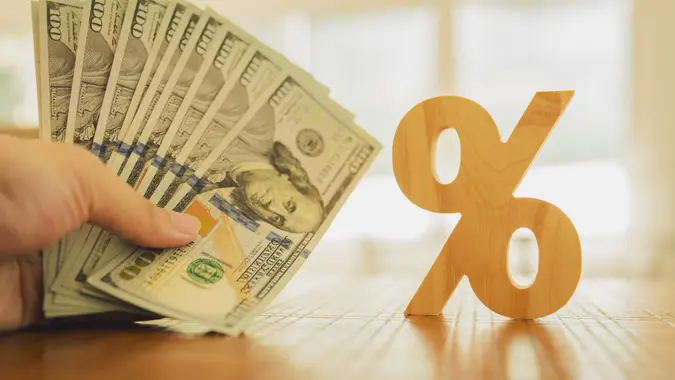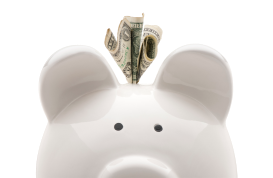3 Interest Rate Cuts Are Coming — But Will They Help the Middle Class?

Commitment to Our Readers
GOBankingRates' editorial team is committed to bringing you unbiased reviews and information. We use data-driven methodologies to evaluate financial products and services - our reviews and ratings are not influenced by advertisers. You can read more about our editorial guidelines and our products and services review methodology.

20 Years
Helping You Live Richer

Reviewed
by Experts

Trusted by
Millions of Readers
Federal Reserve Chair Jerome Powell stated in a recent “60 Minutes” interview that the Fed would cut rates three times this year, noting that nothing had “dramatically” changed since the December Federal Open Market Committee (FOMC) meeting projections.
While the cuts will probably occur later than the previously anticipated March date — due to both inflation and strong economic data — they will occur at some point. This is a development many Americans have been waiting for, as the Fed’s tight monetary policy has, among other things, made borrowing more costly.
Whether these cuts will help the middle class remains to be seen, and some experts argue they might not make much of a difference. According to William Luther, Director of the American Institute for Economic Research’s Sound Money Project, inflation has fallen faster than Fed officials expected over the last few months.
“Consequently, real interest rates are now higher than Fed officials intended. That makes life harder for middle-class Americans,” he said. “Small business owners may struggle to finance operations. And, if real rates remain too high for too long, a recession will eliminate some of the jobs middle class Americans depend on to support their families.”
Some Nuance
Matt Colyar, Moody’s Analytics economist, said that Moody’s expects the Fed’s first cut to come in a May meeting, followed by three more in the second half of this year.
By lowering interest rates, the effect on the U.S. middle class requires some nuance, he noted. For instance, the short term effects are mostly positive; however, should inflation come rearing back because the Fed started cutting rates prematurely, the Fed’s job becomes much more difficult and the remedy much more painful.
“The price of cars, homes and other items quickly rises. A 20% downpayment, for example, can become unaffordable,” said Colyar. “Because lower and middle-income households spend a larger share of their income on essentials, saving for a downpayment is more challenging.”
Joe Camberato, CEO, NationalBusinessCapital.com, echoed the sentiment, deeming the upcoming cuts “a bit of a mixed bag.”
For instance, while high-yield savings accounts (HYSAs) have been very attractive — offering rates upward of 5% compared to an average 0.47% for traditional savings accounts, according to the Federal Deposit Insurance Corporation (FDIC) — their rates could drop significantly, eating away at Americans’ savings.
“Overall,” Camberato added, “while it might sting to see the potential earnings on savings shrink, the benefits of lower loan rates can be a win for the middle class. It’s a trade-off worth considering.”
Some Favorable Middle Class Outcomes
As Moody’s Colyar explained, lower rates would also translate into lower borrowing costs for big ticket items such as mortgages and cars, but also on everyday expenses.
“Lower mortgage rates mean potential buyers can afford more house. For existing homeowners, this boosts their property value. Even if they are not interested in selling, price appreciation means higher equity that can be leveraged for other purposes,” he said.
He noted, however, that higher-income households are more likely to be in position to take advantage of this dynamic, and that homeownership is far and away the biggest asset for most Americans.
Fed Chair Powell himself has conceded several times that high interest rates have been weighing down mortgage rates, leaving many would-be homeowners on the sidelines.
In turn, Michele Raneri, VP and head of U.S. research and consulting at TransUnion, further argued that if interest rates were to drop to even 5.5%, it could result in significant savings for these homeowners, as refinancing at that rate could result in an average monthly payment of $1,917 for them — a reduction of $284 every month.
“This would represent nearly $300 a month that these homeowners would be able to use elsewhere in this continued high cost-of-living environment in which every dollar counts,” she said.
Other areas where middle class Americans could see some relief include credit cards, which have been seeing record high rates. The average-interest credit card rate was 22.95% as of February 5, 2024 — 0.20% higher than the prior month, according to WalletHub.
“Interest rate reductions would decrease card interest rates and could also decrease interest rates for unsecured personal loans and home equity products, allowing many consumers to refinance existing debt,” said Michele Raneri, VP and head of U.S. research and consulting at TransUnion.
What does that mean, exactly? “More money in the pockets of middle-class consumers and households at a time many could certainly use it,” Raneri added.
More From GOBankingRates
- 5 Japanese Cars To Stay Away From Buying
- Ramit Sethi: How To Become Rich on a Low Salary
- 16 Best Places To Retire in the US That Feel Like Europe
- 3 Things You Must Do When Your Savings Reach $50,000
 Written by
Written by  Edited by
Edited by 























